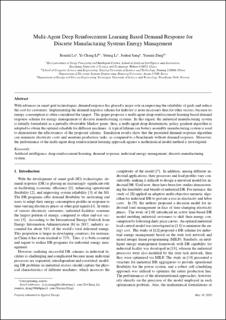| dc.contributor.author | Lu, Renzhi | |
| dc.contributor.author | Li, Yi-Chang | |
| dc.contributor.author | Li, Yuting | |
| dc.contributor.author | Jiang, Junhui | |
| dc.contributor.author | Ding, Yuemin | |
| dc.date.accessioned | 2021-02-25T09:12:00Z | |
| dc.date.available | 2021-02-25T09:12:00Z | |
| dc.date.created | 2020-12-16T16:07:59Z | |
| dc.date.issued | 2020 | |
| dc.identifier.citation | Applied Energy. 2020, 276 . | en_US |
| dc.identifier.issn | 0306-2619 | |
| dc.identifier.uri | https://hdl.handle.net/11250/2730273 | |
| dc.description.abstract | With advances in smart grid technologies, demand response has played a major role in improving the reliability of grids and reduce the cost for customers. Implementing the demand response scheme for industry is more necessary than for other sectors, because its energy consumption is often considered the largest. This paper proposes a multi-agent deep reinforcement learning based demand response scheme for energy management of discrete manufacturing systems. In this regard, the industrial manufacturing system is initially formulated as a partially-observable Markov game; then, a multi-agent deep deterministic policy gradient algorithm is adopted to obtain the optimal schedule for different machines. A typical lithium-ion battery assembly manufacturing system is used to demonstrate the effectiveness of the proposed scheme. Simulation results show that the presented demand response algorithm can minimize electricity costs and maintain production tasks, as compared to a benchmark without demand response. Moreover, the performance of the multi-agent deep reinforcement learning approach against a mathematical model method is investigated. | en_US |
| dc.language.iso | eng | en_US |
| dc.publisher | Elsevier | en_US |
| dc.rights | Attribution-NonCommercial-NoDerivatives 4.0 Internasjonal | * |
| dc.rights.uri | http://creativecommons.org/licenses/by-nc-nd/4.0/deed.no | * |
| dc.title | Multi-agent deep reinforcement learning based demand response for discrete manufacturing systems energy management | en_US |
| dc.type | Peer reviewed | en_US |
| dc.type | Journal article | en_US |
| dc.description.version | acceptedVersion | en_US |
| dc.source.pagenumber | 10 | en_US |
| dc.source.volume | 276 | en_US |
| dc.source.journal | Applied Energy | en_US |
| dc.identifier.doi | 10.1016/j.apenergy.2020.115473 | |
| dc.identifier.cristin | 1860672 | |
| dc.description.localcode | "© 2020. This is the authors’ accepted and refereed manuscript to the article. Locked until 12.7.2022 due to copyright restrictions. This manuscript version is made available under the CC-BY-NC-ND 4.0 license http://creativecommons.org/licenses/by-nc-nd/4.0/ " | en_US |
| cristin.ispublished | true | |
| cristin.fulltext | postprint | |
| cristin.qualitycode | 1 | |

